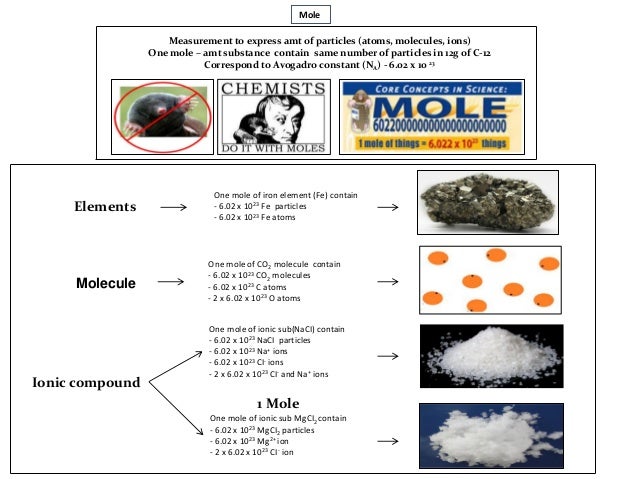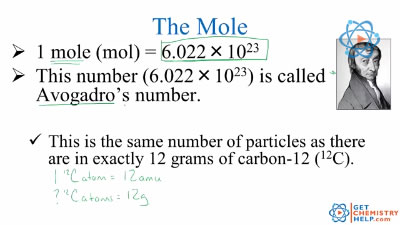Chemistry Mole Number
There are about 20 species of fuzzy moles (the kind that crawl around on the ground), and one kind of mole that might appear on your face, but today is a day for celebrating a different kind of mole. Today’s mole is a unit — one invented by a man named Avogadro.
Really, a mole is just a group of objects. You can think of “a mole” the same way you think of “a dozen.” You’re probably familiar with a dozen eggs, or chickens or planets. Moles are no different. You can have a mole of molecules or people or cheeseburgers. But there are a lot more than twelve things in a mole — there are 6.02 x 1023. That’s 602,000,000,000,000,000,000,000 things. Because the mole contains so many units, they’re most often used in chemistry is a way of measuring really really small things like atoms or molecules.
The mole (abbreviated mol) is the SI measure of quantity of a “chemical entity,” such as atoms, electrons, or protons. It is defined as the amount of a substance that contains as many particles as there are atoms in 12 grams of pure carbon-12. So, 1 mol contains 6.022×10 23 elementary entities of the substance. In the field of chemistry, a mole is defined as the amount of a substance that contains exactly 6.02214076. 10 23 ‘elementary entities’ of the given substance. The number 6.02214076.10 23 is popularly known as the Avogadro constant and is often denoted by the symbol ‘N A ’. The elementary entities that can be.
So a mole of water is 6.02 x 1023 molecules of water, which works out to be about 18 grams, or 18 mL. A mole of aluminum is about 26 grams. But to really appreciate how many molecules are in a mole it helps to think about things we can see. To do that, let’s try these comparisons from Daniel Dulek’s lesson about how big a mole is.
Mole Chemistry Definition Number
A way to think about the relative size of a mole?
If you had a mole of doughnuts, they would cover the entire Earth in a doughnut-layer five miles deep.
If you had a mole of basketballs, you could create a new planet the size of the Earth!
If you received a mole of pennies on the day you were born, and spent a million dollars a second until you died at 100, you’d still have over 99.99% of your money in the bank.
One mole of red blood cells is more red blood cells than exist in every human on earth right now. A mole of cereal boxes stacked end to end would reach from the Sun to Pluto 7.5 million times. A mole of turkeys could form sixteen earths.
Okay, so now that we know why a mole has 6.02 x 1023 things in it, what can we do with that information? Moles in chemistry are far more useful than moles in the ground, or on your face. They factor into all kinds of equations and important concepts in chemistry. Chemists think of moles or atoms like you and I think of a dozen eggs – we add them to recipes, order them from the store and calculate what we need based on how many we have.
What would a mole of fuzzy moles look like? Well, the pile of animals would weigh a little over half of the mass of our moon. Thankfully, there’s no chemistry equation in the world that calls for that many mammals. But if there was, you’d now know just how many mammals that would be.
Contrary to the beliefs of generations of chemistry students, Avogadro’s number—the number of particles in a unit known as a mole—was not discovered by Amadeo Avogadro (1776-1856). Avogadro was a lawyer who became interested in mathematics and physics, and in 1820 he became the first professor of physics in Italy. Avogadro is most famous for his hypothesis that equal volumes of different gases at the same temperature and pressure contain the same number of particles.
Define Mole

The first person to estimate the actual number of particles in a given amount of a substance was Josef Loschmidt, an Austrian high school teacher who later became a professor at the University of Vienna. In 1865 Loschmidt used kinetic molecular theory to estimate the number of particles in one cubic centimeter of gas at standard conditions. This quantity is now known as the Loschmidt constant, and the accepted value of this constant is 2.6867773 x 1025 m-3.
The term “Avogadro’s number” was first used by French physicist Jean Baptiste Perrin. In 1909 Perrin reported an estimate of Avogadro’s number based on his work on Brownian motion—the random movement of microscopic particles suspended in a liquid or gas. In the years since then, a variety of techniques have been used to estimate the magnitude of this fundamental constant.
Accurate determinations of Avogadro’s number require the measurement of a single quantity on both the atomic and macroscopic scales using the same unit of measurement. This became possible for the first time when American physicist Robert Millikan measured the charge on an electron. The charge on a mole of electrons had been known for some time and is the constant called the Faraday. The best estimate of the value of a Faraday, according to the National Institute of Standards and Technology (NIST), is 96,485.3383 coulombs per mole of electrons. The best estimate of the charge on an electron based on modern experiments is 1.60217653 x 10-19 coulombs per electron. If you divide the charge on a mole of electrons by the charge on a single electron you obtain a value of Avogadro’s number of 6.02214154 x 1023 particles per mole.
Chemistry Mole Number Of Bonds
Another approach to determining Avogadro’s number starts with careful measurements of the density of an ultrapure sample of a material on the macroscopic scale. The density of this material on the atomic scale is then measured by using x-ray diffraction techniques to determine the number of atoms per unit cell in the crystal and the distance between the equivalent points that define the unit cell (see Physical Review Letters, 1974, 33, 464).


